
If you train BJJ, knowing some tricks with the lapels to attack your opponent can be very useful, so don’t disregard the advantages the gi offers you.
Some people don’t like training with the gi. I have no problem with that if your only focus is no-gi competition; if that’s you, then by all means, train specifically for your sport.
But if self-defense is important to you, then you should DEFINITELY train gi and no gi. Most real-life attackers are going to be wearing more than just board shorts, and if they’ve got clothes on, then you can use that material to control or choke them. A little can go a long way here: even if you train 90% in one modality and only 10% in the other you’ll still learn enough to be comfortable in a fight no matter what the other guy is wearing.
So with that in mind, let’s take a look at four of my favourite lapel-based attacks from the top…
Table of Contents
Four Lapel-Based Attacks from Side Control in Video
Here are four of my favorite sneaky attacks from side control in BJJ. Jump to specific techniques you’re interested in using the timestamps below…
TIMESTAMPS
00:03 Far side shoulder pin to take the back
01:20 Lapel wrap around far arm to Kimura armlock
02:13 Lapel wrap to baseball bat choke
02:54 Assassin choke with own lapel
Far Side Shoulder Trap Backtake in Pictures
One of the most popular ways to escape side control is the hip escape. Consequently, you have to know some counters to this escape if you’re going to be well rounded at jiu-jitsu.
In this escape the guy on bottom is trying to bridge into you, move his hips away to create room, and put you back into the guard.
This counter technique shuts down the hip escape because it makes it almost impossible for him to turn and face you.
Since he can’t turn into you he’ll now probably turn away from you. You can be ready for his likely response and take advantage of it when it comes!
Let’s see what that looks like…

You’re on your opponent’s left side in side control but he’s bridging, shrimping, and trying to put you back into the guard all the time. Let’s shut down that option.

With your right hand open up his left lapel (the lapel that’s furthest away from you). Sometimes his lapel will have opened naturally while rolling, in which case this technique is even easier. Try to be subtle about gripping his lapel so that his spider sense doesn’t tingle.

Bring his lapel up under his left arm and feed it to your right hand. Pull the material tight through his armpit.

Your right arm now comes under his head and controls his left lapel. This pins his left shoulder firmly to the ground and makes it very difficult for him to turn into you.

He’ll likely fight to get his right arm free, turn away, and come to his knees. Once on his knees he might continue rolling through, half granby back to guard, stand up back to the feet, or fight you from the turtle position.
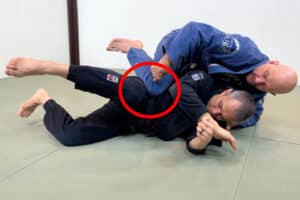
You can slow his roll down by resting your right knee on his right hip; this position looks vaguely like a knee-on-belly position, and the weight you transfer onto him this way makes it much harder for him to do this movement explosively.

Once he’s turned belly down he’ll then need to lift his hips off the ground to get to his knees. This lifting motion inevitably creates an opening on his bottom side; anticipate this opening and slide your left leg into position using the low hook backtake to establish the first of two hooks.

Continue to control his left shoulder with your lapel grip, and insert your top hook. Establish cross-body rotational control by underhooking his right arm with your right arm. Congratulations, you’re now in rear mount, one of the most dominant positions in all of jiu-jitsu with a ton of submission options!
To see this technique in action either go to the very beginning of the video at the top of this page, or click here to view just this move as a Youtube Short.
Lapel Trap Kimura in Pictures
The lapel trap Kimura is a technique from Judo and has an impeccable lineage.
It was popularised by Masahiko Kimura himself (yes, that Kimura, the guy who beat up Helio Gracie in Brazil), who often used it to pass half guard. Given how influential Kimura was on the sport of Judo it’s not surprising that this technique continues to be used to this day.
Let’s take a look at how we can use this same gripping strategy to control and submit an opponent in Jiu-Jitsu…
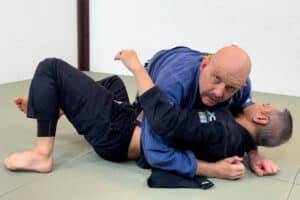
Let’s say that you’re in side control and your opponent’s left arm has drifted to the right side of your head. This is a trigger position for the Kimura attack.

Bring your top (left) arm around his triceps/biceps area to isolate his arm and hunt for the submission.
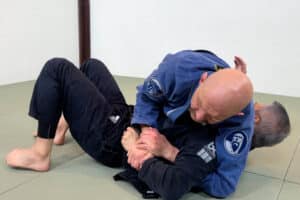
Achieve a strong Kimura grip on your opponent’s left arm. He’s now in very real danger of getting submitted, so he’ll likely try to lock his arm in place by grabbing his belt or his gi pants with his left hand.

In the orthodox Kimura grip your right hand controls your opponent’s left wrist, and your left hand grips your own wrist.
We now switch that so your left wrist controls his left wrist, which leaves your right hand free.

Maintaining control over his trapped hand, grab the end of his left lapel with your right hand and stretch it out.

Now bring his left lapel back towards you over top of his left wrist. Stretch it tight in order to take all the slack out of the lapel.
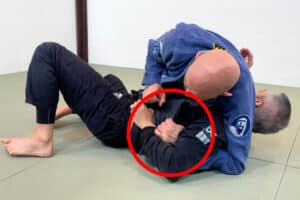
Your left hand was previously controlling his left wrist, but now switches to grip the end of the lapel. This forms a noose around his hand; it’s now very difficult for him to escape his left arm even if he lets go of his belt or gi pants and you have him trapped!

If you want to continue hunting the Kimura armlock then break his grip by using your right elbow on the back of his left hand, pushing it down to the mat to break his grip.

Twist his spine to weaken his posture by pulling his legs towards you with your right hand to induce a spinal twist.

To finish the Kimura submission one-handed extend your left arm to bring his arm behind his body. Be gentle here and leave lots of time for him to tap out – the Kimura shoulder lock comes on quickly!
To see this technique in action either go 1:20 in the video at the top of this page, or click here to view just this move as a Youtube Short.
Wrist Trap to Baseball Bat Choke in Pictures
In the previous technique we trapped our opponent’s arm near his waist in the ‘branch down’ position. Now we’re going to use a similar technique to trap his arm in the ‘branch up’ position.
By mastering both the lapel trap Kimura and the wrist trap you’ll always have a way to immobilise and attack him from the top.

You’re on your opponent’s right side but he’s framing into your neck with his left arm. This is both extremely annoying and a good way for him to escape, so let’s shut that nonsense down!

While he’s pushing on your neck use your right hand to open his left lapel and grip the end of of it.

Sit up slightly to create some room and feed his left lapel up and over his left wrist towards your left hand.

Your left arm comes under his head, and your left hand now grips the end of his left lapel. His left arm is now held in place by his own lapel, leaving your left hand free.

One powerful finish here is the baseball bat choke. To do this attack grip the same lapel with your right hand as well.
Your hands are now stacked, one on top of the other, just like you’d hold a baseball bat, the difference being that his neck is trapped in front and in back by your forearms.

To finish this choke rotate your body towards his head and drop your right elbow down to the floor, close to his armpit. This creates a very powerful papercutter effect on his neck that’ll force almost every opponent to tap out immediately.
To see this technique in action either go 2:13 in the video at the top of this page, or click here to view just this move as a Youtube Short.
Assassin Choke Using Your Own Lapel in Pictures
This submission has many names: the assassin choke, the ninja choke, the Jacare choke, and more. It was a favorite of Brazilian jiu-jitsuka Ronaldo ‘Jacare’ Souza, and it’s one of my favorites as well. Let’s get to it…
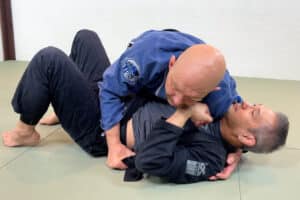
Start in side control and put heavy pressure on your opponent’s face with your shoulder. This encourages him to frame against your neck with his left forearm, which is exactly what you want.

Open up your own right lapel with your right hand, making sure to keep your body in front of his face so he can’t see what’s going on.

Control his near (right) leg with your right arm while still gripping your own lapel with that same hand. This is a misdirection; because he can feel your grip on his leg he will probably assume that you’re not holding your lapel anymore.

Turn to face your opponent and feed your lapel under his left forearm and into your right hand which is coming under his head. This creates the noose with which you will now choke him.
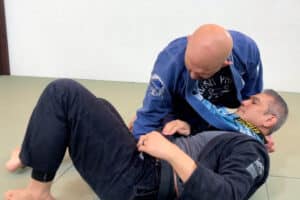
Turn towards his legs and put your right hand on the ground next to his right hip. This blocks his hip and prevents him from following as you continue to twist to your right and tighten the choke.

Sometimes all your need to apply the submission is to block his hip with your hand and twist to the right. More often you’ll end up replacing your right hand on the mat with your head, which significantly tightens the choke. If you need even more power here you can pike up and begin to step over his head.
To see this technique in action either go 2:54 in the video at the top of this page, or click here to view just this move as a Youtube Short.
I hope you found this useful. Continue scrolling down to check out other techniques and resources on Grapplearts…
18 Variations of Side Control
Side control is a pinning position in Brazilian jiu-jitsu when you’re perpendicular to your opponent and are not entangled in their legs. Typically but not always you’re chest to chest with your opponent.
But there isn’t just one perfect version of side control. Depending on what you’re trying to set up and depending on how your opponent is trying to escape you can have your arms, legs, hips and body in a number of different positions, each with its own advantages and disadvantages.
Click here to make sure you know all these variations of side control!
The Five Types of Triangle Choke You Need to Know
Every variation of triangle choke involves forming a triangle around the neck of your opponent and one of his arms.
Usually this triangle is formed with your legs by tucking one ankle behind the knee of your other leg before you squeeze to get the choke. In some variations, however, you can use your arms to form the triangle shape as well.
His arm being inside your legs is important; it’s a combination of your leg against one side of his neck and his own shoulder against the other side of his neck that makes this choke so effective!
Click here to learn all 5 types of triangle choke.
The 3 Most Important Concepts in BJJ
Body alignment in BJJ can be broken down into 3 components (base, posture and structure), and I have found these 3 concepts to have hugely practical applications on the mat.
There is power in definitions and distinctions because it allows you to clarify your thinking and problem solving processes. So let’s take a look at base, posture and structure one by one…
Click here to better understand the most important concepts in jiu-jitsu!
A Roadmap for Brazilian Jiu-Jitsu
The Roadmap for Brazilian Jiu-Jitsu is a book I wrote that breaks down the fundamental six positions of BJJ, the positional strategies that control everything that happens on the mats, and the techniques and transitions that every student should know.
It’s absolutely free, and has been downloaded over 100,000 times.
Click here to download your copy of A Roadmap for Brazilian Jiu-Jitsu completely for free.
Thanks,
Stephan Kesting








